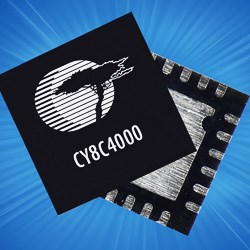Cypress – New Low-Cost PSoC Devices Offer Design Engineers Seamless Upgrade Path To A 32-Bit ARM Based Systems (PSoC 4000 Family)

A new product family employing its PSoC 4 architecture has been unveiled by Cypress Semiconductor, offering offers a low-cost, entry-level 32-bit ARM-based system-on-chip for quick, simple upgrades of legacy 8-bit and 16-bit MCUs.
The PSoC 4000 family delivers PSoC’s hallmark design flexibility, along with CapSense, Cypress’s industry-leading capacitive sensing technology, to cost-sensitive and high-volume applications. PSoC 4000 devices have a truly scalable architecture that enables seamless migration to larger PSoC 4 families.
The PSoC 4000 family also integrates programmable digital and analog peripherals, for functions such as Timers, Counters, Pulse Width Modulators (PWMs), I2C and Comparators, to suit a variety of consumer and industrial applications. The devices are available in extremely small-footprint package options down to 3mm x 3mm x 0.6mm. The scalable, cost-efficient architecture is complemented by the free, downloadable PSoC Creator Integrated Design Environment (IDE), which simplifies system design and accelerates time-to-market by allowing hardware and firmware co-design, says the company.
“The PSoC 4000 family is the world’s lowest ARM-Cortex-M0 system-on-chip with the right mix of performance, power and peripherals to make migration to 32-bit a no-brainer,” said John Weil, senior director of PSoC marketing and applications, Cypress Programmable Systems Division. “There is no simpler way to design your next-generation product with this robust core and the added value of a sophisticated capacitive sensing solution.”
The PSoC 4000 devices enable touch user interface designs with up to 16 CapSense I/Os that can be used to implement buttons, sliders and proximity sensors. CapSense delivers robust sensing in noisy environments using Cypress’s patented CapSense Sigma-Delta (CSD) sensing method, ensuring superior immunity to conducted and radiated noise with a signal-to-noise ratio of greater than 100:1. Operating from 1.71V to 5.5V, the PSoC devices are ideal for a wide range of regulated and unregulated battery applications, including single coin cell battery operation.
Cypress also offers larger families in the PSoC 4 architecture that integrate discrete analog and digital glue logic to facilitate high-performance custom signal chains.
The PSoC 4000 family is currently sampling with production expected in May 2014. Parts will be available in 8-pin SOIC, 16-pin QFN, 16-pin SOIC or 24-pin QFN packages.
MCUs Can’t – PSoC can : PSoC solutions bring the flash-based equivalent of a field-programmable ASIC to embedded designs without lead-time or NRE penalties. PSoC integrates configurable analog and digital circuits with an on-chip microcontroller, reducing component count and simplifying revisions. A single PSoC device can integrate as many as 100 peripheral functions, accelerating cycle time and improving quality while reducing board space, power consumption, and system cost. PSoC future-proofs designs, protecting them against last-minute specifications changes. It enables firmware-based changes at any point in the design cycle—even out in the field. All PSoC devices are dynamically reconfigurable, enabling designers to transform resources on-the-fly and to execute tasks with fewer ICs, says the company.
Source: Cypress
